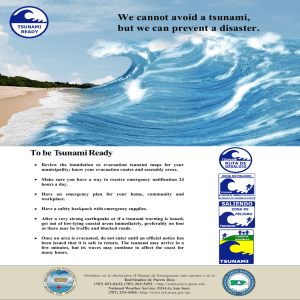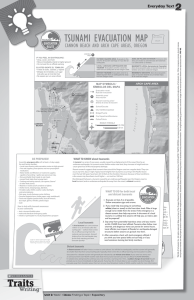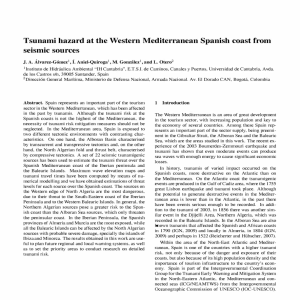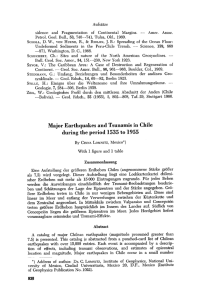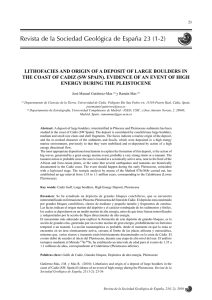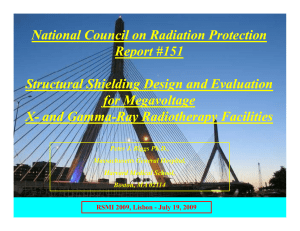The Holocene record of tsunamis in the southwestern Iberian Margin
Anuncio
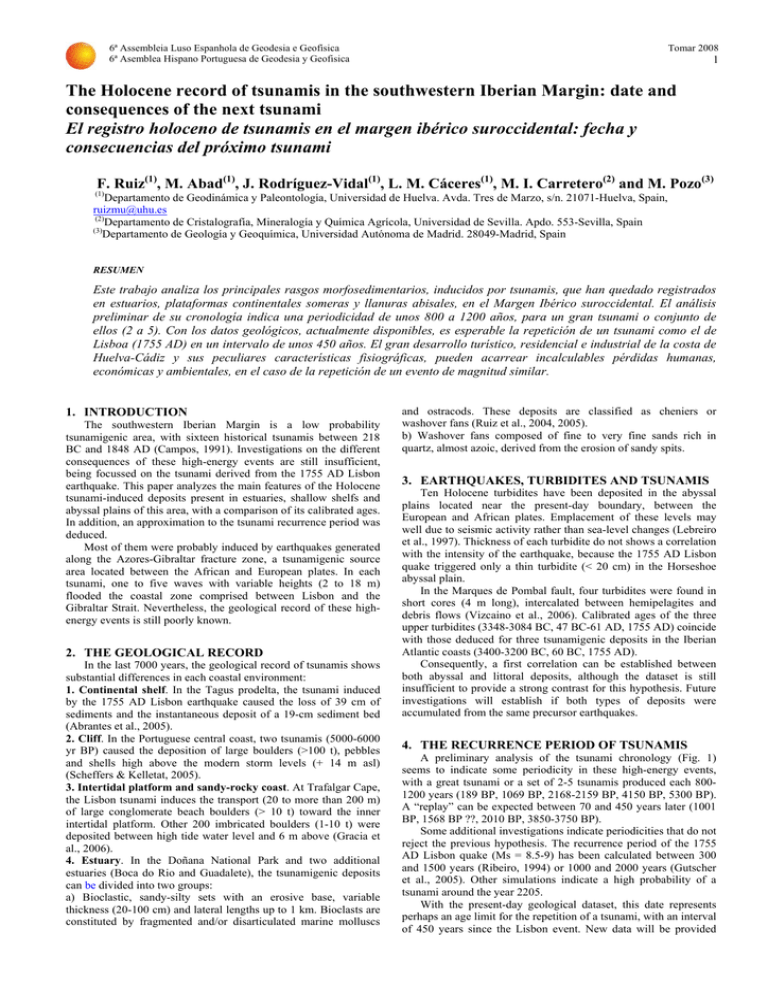
6ª Assembleia Luso Espanhola de Geodesia e Geofísica 6ª Asemblea Hispano Portuguesa de Geodesia y Geofisica Tomar 2008 1 The Holocene record of tsunamis in the southwestern Iberian Margin: date and consequences of the next tsunami El registro holoceno de tsunamis en el margen ibérico suroccidental: fecha y consecuencias del próximo tsunami F. Ruiz(1), M. Abad(1), J. Rodríguez-Vidal(1), L. M. Cáceres(1), M. I. Carretero(2) and M. Pozo(3) (1) Departamento de Geodinámica y Paleontología, Universidad de Huelva. Avda. Tres de Marzo, s/n. 21071-Huelva, Spain, ruizmu@uhu.es (2) Departamento de Cristalografía, Mineralogía y Química Agrícola, Universidad de Sevilla. Apdo. 553-Sevilla, Spain (3) Departamento de Geología y Geoquímica, Universidad Autónoma de Madrid. 28049-Madrid, Spain RESUMEN Este trabajo analiza los principales rasgos morfosedimentarios, inducidos por tsunamis, que han quedado registrados en estuarios, plataformas continentales someras y llanuras abisales, en el Margen Ibérico suroccidental. El análisis preliminar de su cronología indica una periodicidad de unos 800 a 1200 años, para un gran tsunami o conjunto de ellos (2 a 5). Con los datos geológicos, actualmente disponibles, es esperable la repetición de un tsunami como el de Lisboa (1755 AD) en un intervalo de unos 450 años. El gran desarrollo turístico, residencial e industrial de la costa de Huelva-Cádiz y sus peculiares características fisiográficas, pueden acarrear incalculables pérdidas humanas, económicas y ambientales, en el caso de la repetición de un evento de magnitud similar. 1. INTRODUCTION The southwestern Iberian Margin is a low probability tsunamigenic area, with sixteen historical tsunamis between 218 BC and 1848 AD (Campos, 1991). Investigations on the different consequences of these high-energy events are still insufficient, being focussed on the tsunami derived from the 1755 AD Lisbon earthquake. This paper analyzes the main features of the Holocene tsunami-induced deposits present in estuaries, shallow shelfs and abyssal plains of this area, with a comparison of its calibrated ages. In addition, an approximation to the tsunami recurrence period was deduced. Most of them were probably induced by earthquakes generated along the Azores-Gibraltar fracture zone, a tsunamigenic source area located between the African and European plates. In each tsunami, one to five waves with variable heights (2 to 18 m) flooded the coastal zone comprised between Lisbon and the Gibraltar Strait. Nevertheless, the geological record of these highenergy events is still poorly known. 2. THE GEOLOGICAL RECORD In the last 7000 years, the geological record of tsunamis shows substantial differences in each coastal environment: 1. Continental shelf. In the Tagus prodelta, the tsunami induced by the 1755 AD Lisbon earthquake caused the loss of 39 cm of sediments and the instantaneous deposit of a 19-cm sediment bed (Abrantes et al., 2005). 2. Cliff. In the Portuguese central coast, two tsunamis (5000-6000 yr BP) caused the deposition of large boulders (>100 t), pebbles and shells high above the modern storm levels (+ 14 m asl) (Scheffers & Kelletat, 2005). 3. Intertidal platform and sandy-rocky coast. At Trafalgar Cape, the Lisbon tsunami induces the transport (20 to more than 200 m) of large conglomerate beach boulders (> 10 t) toward the inner intertidal platform. Other 200 imbricated boulders (1-10 t) were deposited between high tide water level and 6 m above (Gracia et al., 2006). 4. Estuary. In the Doñana National Park and two additional estuaries (Boca do Rio and Guadalete), the tsunamigenic deposits can be divided into two groups: a) Bioclastic, sandy-silty sets with an erosive base, variable thickness (20-100 cm) and lateral lengths up to 1 km. Bioclasts are constituted by fragmented and/or disarticulated marine molluscs and ostracods. These deposits are classified as cheniers or washover fans (Ruiz et al., 2004, 2005). b) Washover fans composed of fine to very fine sands rich in quartz, almost azoic, derived from the erosion of sandy spits. 3. EARTHQUAKES, TURBIDITES AND TSUNAMIS Ten Holocene turbidites have been deposited in the abyssal plains located near the present-day boundary, between the European and African plates. Emplacement of these levels may well due to seismic activity rather than sea-level changes (Lebreiro et al., 1997). Thickness of each turbidite do not shows a correlation with the intensity of the earthquake, because the 1755 AD Lisbon quake triggered only a thin turbidite (< 20 cm) in the Horseshoe abyssal plain. In the Marques de Pombal fault, four turbidites were found in short cores (4 m long), intercalated between hemipelagites and debris flows (Vizcaino et al., 2006). Calibrated ages of the three upper turbidites (3348-3084 BC, 47 BC-61 AD, 1755 AD) coincide with those deduced for three tsunamigenic deposits in the Iberian Atlantic coasts (3400-3200 BC, 60 BC, 1755 AD). Consequently, a first correlation can be established between both abyssal and littoral deposits, although the dataset is still insufficient to provide a strong contrast for this hypothesis. Future investigations will establish if both types of deposits were accumulated from the same precursor earthquakes. 4. THE RECURRENCE PERIOD OF TSUNAMIS A preliminary analysis of the tsunami chronology (Fig. 1) seems to indicate some periodicity in these high-energy events, with a great tsunami or a set of 2-5 tsunamis produced each 8001200 years (189 BP, 1069 BP, 2168-2159 BP, 4150 BP, 5300 BP). A “replay” can be expected between 70 and 450 years later (1001 BP, 1568 BP ??, 2010 BP, 3850-3750 BP). Some additional investigations indicate periodicities that do not reject the previous hypothesis. The recurrence period of the 1755 AD Lisbon quake (Ms = 8.5-9) has been calculated between 300 and 1500 years (Ribeiro, 1994) or 1000 and 2000 years (Gutscher et al., 2005). Other simulations indicate a high probability of a tsunami around the year 2205. With the present-day geological dataset, this date represents perhaps an age limit for the repetition of a tsunami, with an interval of 450 years since the Lisbon event. New data will be provided Tomar 2008 2 with future studies of the geological record comprised between 2200 BP and 7000 BP, together with the application of spectral analysis. 6ª Assembleia Luso Espanhola de Geodesia e Geofísica 6ª Asemblea Hispano Portuguesa de Geodesia y Geofisica Although a tsunami is impossible to predict, some preventive measures are necessary: a) An alert system, b) New studies focussed on the effects of a tsunami in different coastal stretches, c) A general contingency plan, d) Limitation of new buildings in risk areas, and e) Promotion of educational activities with tsunamis simulations. 6. ACKNOWLEDGEMENTS This work was funded by two Spanish DGYCIT Projects (CTM2006-06722 and CGL2006-01412) and three Research Groups of the Andalousia Board (RNM-135, RNM-238 and RNM293). It is a contribution to the projects IGCP 495 and 526. 7. REFERENCES Figure 1 – Chronology of tsunamis in the Southwestern Iberian Margin during the last 7000 years. (Cronología de tsunamis en el Margen Ibérico suroccidental durante los últimos 7000 años). 5. THE EFFECTS OF A TSUNAMI The 1755 AD earthquake and the associated tsunami caused the destruction of numerous towns in Portugal, Spain and Morocco. In Spain, the number of victims was probably around 2000 and the total economic losses amounted to a total of approximately 70 million reales de vellón (536 million euros, year 2002). These economic losses implied a fifth of the state expenditure for the year 1755 in Spain (Martínez Solares y López Arroyo, 2004). Effects of the next tsunami will be even more devastating in the Huelva province, numerous residential areas are situated very close to the coastline (< 100 m) and can be destroyed. Other towns (e.g. Punta Umbria) are located in a peninsula, with important difficulties to evacuate them (at least partially) in a few minutes. On the other hand, the human losses can increase during the summer weekends, with more than one million of tourists in these beaches. Abrantes, F., S. Lebreiro, T. Rodrigues, I. Gil, H. Bartels-Jónsdóffir, P. Oliveira, P. Kissel and J. O. Grimalt (2005). “Shallow marine sediment cores record climate variability and earthquake activity of Lisbon (Portugal) for the last 2000 years”. Quaternary Science Reviews, 24, 2477-2494. Campos, M. L. (1991). “Tsunami hazard on the Spanish coast of the Iberian Peninsula”. The Science of the Tsunami Hazards, 9, 83-90. Gracia, F. J., C. Alonso, J. Benavente, G. Anfuso and L. del Río (2006). “The different coastal records of the 1755 tsunami waves along the south Atlantic Spanish coast”. Z. Geomorphologie N.F., 146, 195220. Gutscher, M. A., M. A. Baptista and J. M. Miranda (2005). “The Gibraltar Arc seismogenetic zone (part 2). Constraints on a shallow east dipping fault plane source for the 1755 Lisbon earthquake provided by tsunami modelling and seismic intensity”. Tectonophysics, 426, 152-166. Lebreiro, S. M., N. McCave and P. P. E. Weaver (1997). “Late Quaternary turbidite emplacement on the Horseshoe abyssal plain (Iberian Margin)”. Journal of Sedimentary Research, 67, 856-870. Luque, L. (2002). “Último y presente Interglacial en el área de conexión Atlántico-Mediterráneo: variaciones en el nivel del mar, paleoclima y paleoambientes”. Tesis Doctoral, Universidad Complutense de Madrid. Martínez Solares, J. M. and A. López Arroyo (2004). “The great historical earthquake. Effects and damage in Spain”. Journal of Seismology, 8, 275-294. Ribeiro, A. (1994). “Deformable plate tectonics of the Azores-Gibraltar boundary: where the next 1755 earthquake will strike again?”. In 1er Simposio sobre a margem continental Ibérica Atlántica, Gaia, 9, Lisboa. Ruiz, F., A. Rodríguez-Ramírez, L. M. Cáceres, J. Rodríguez-Vidal, M. I. Carretero, L. Clemente, J. M. Muñoz, C. Yañez and M. Abad (2004). “Late Holocene evolution of the southwestern Doñana National Park (Guadalquivir estuary, SW Spain): a multivariate approach”. Palaeogeography, Palaeoclimatology, Palaeoecology, 204, 47-64 Ruiz, F., A. Rodríguez-Ramírez, L. M. Cáceres, J. Rodríguez-Vidal, M. I. Carretero, M. Abad, M. Olías and M. Pozo (2005). “ Evidence of high-energy events in the geological record: Mid-Holocene evolution of the southwestern Doñana Nacional Park (SW Spain)”. Palaeogeography, Palaeoclimatology, Palaeoecology, 229, 212-229. Scheffers, A. and D. Kelletat (2005). “Tsunami relics on the coastal landscape west of Lisbon, Portugal”. The Science of the Tsunami Hazards, 23, 3-16. Vizcaino, A., E. Gràcia, R. Pallás, J. García-Orellana, C. Escutia, D. Casas, V. Wilmott, S. Díez, A. Asioli and J. J. Dañobeitia (2006). “Sedimentology, physical properties and ages of mass-transport deposits associated to the Marqués de Pombal Fault, Southwest Portuguese Margin”. Norvegian Journal of Geology, 86, 177-186.
